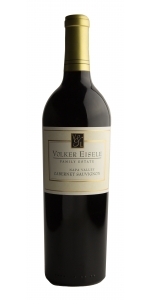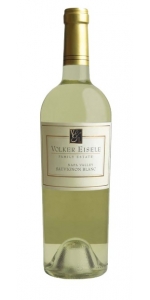Wine from Volker Eisele Family Estate
Volker Eisele Family Estate creates enticing wines from the Chiles Valley District of the Napa Valley. Organically farmed since 1974, the vineyard reflects the passion of the Eisele Family’s commitment to grow exceptional grapes and to produce elegant estate wines.
VINEYARD
Volker Eisele Family Estate is situated in the Chiles Valley District, a sub-appellation of the Napa Valley American Viticultural Area. Cloaked in frequent Pacific fog, and with elevations of 600-1200 feet, the Chiles Valley District is one of the cooler areas of the Napa Valley resulting in a long growing season. The valley’s perfect cabernet climate enhances the development of wines with subtle flavors, full body, and overall complexity.
The Estate’s sixty acres of vineyard grow at elevations of 900 to 1100 feet on east, west and south facing slopes as well as on the valley floor. Soils vary from clay-loam to shale. After purchase of the vineyard property, the Eisele’s began an extensive redevelopment and restoration of both the vineyard acreage and the riparian corridors. Presently 72% of the vineyard is planted in Cabernet Sauvignon, 12.5% Merlot, 10.5% Cabernet Franc, 3% Semillon and 2% Sauvignon Blanc. Seven different Cabernet clones have been incorporated to provide diversity of flavor.
Since 1974 the Eisele’s have enriched the vineyard soils through use of organic farming practices. No herbicides, pesticides or chemical fertilizers have been used. The vineyard is certified as organic by both the California Certified Organic Farmers and the California Department of Food and Agriculture. It has been set back from the property’s creeks to substantially increase riparian vegetation. Oaks and other native tree species have been planted on the creek banks to prevent erosion. Throughout the property creeks and associated riparian areas have been protected and enhanced.
HISTORY
The four hundred acre estate was originally part of the “Rancho Catacula” land grant, given to Joseph Ballinger Chiles in 1843 by the last Mexican governor of California. The Chiles family later sold a portion of their land to Francis Sievers, a German pioneer. In the 1870’s, Sievers founded Lomita’s Vineyard and Winery on the site. The original winery building, some of the tanks, and the original press still remain on the Estate. The oldest cabernet vines were planted by the Eisele’s in 1976 and continue to yield fruit of superb quality.
Volker Eisele Cabernet Sauvignon Napa Valley is made from 75% Cabernet Sauvignon, 25% Merlot.
Volker Eisele Family Estate Cabernet Sauvignon is a blend of vineyard blocks from throughout the entire estate. Varying terrain, different clones, and different rootstocks produce a patchwork of flavor identities between the vineyard blocks and their resulting cuvees, brought together in a blend that is essentially a snapshot in time of a dynamic, ever-changing vineyard.
The 2015 Volker Eisele Family Estate Cabernet Sauvignon is a brilliant garnet color in the glass. The nose is extroverted and effusive with bright red aromas of ripe cherries and plums, with a touch of peach and hint of anise and white pepper. In the mouth, the wine shows excellent oak integration, with prominent flavors of juicy huckleberries, milk chocolate, and sweet barrel spices. The lengthy finish carries nutmeg, cinnamon, and vanilla through to the end. ~Molly Lippitt, Winemaker.
The 2023 Sauvignon Blanc shows abundant aromas of Meyer lemon, passionfruit, and jasmine. In the mouth, the Semillon shows itself with a rich, deliciously textured palate with flavors of orange blossom, mandarin oranges, and a wet stone minerality
The 2023 Sauvignon Blanc shows abundant aromas of Meyer lemon, passionfruit, and jasmine. In the mouth, the Semillon shows itself with a rich, deliciously textured palate with flavors of orange blossom, mandarin oranges, and a wet stone minerality
- back
Selected Options
Wineries
Categories
Pricing
Countries
Regions
Grape Types
Wineries
Organic/Free Shipping
Named after Allen's granddaughter, Julia's Dazzle is light pink in color and offers aromas of strawberry and orange peel. It is a dry style but with sweet fruit flavors and clean sharp acidity creating a light and refreshing finish.
This Rosé has a bright, eye-catching orange-strawberry color and is dry in style with sweet fruit flavors in the mouth.
Gilles selected a block of Pinot Grigio and gave it extended time on the vine to develop a bright tint through slow fermentation, then added 2% Sangiovese to the blend for color.






